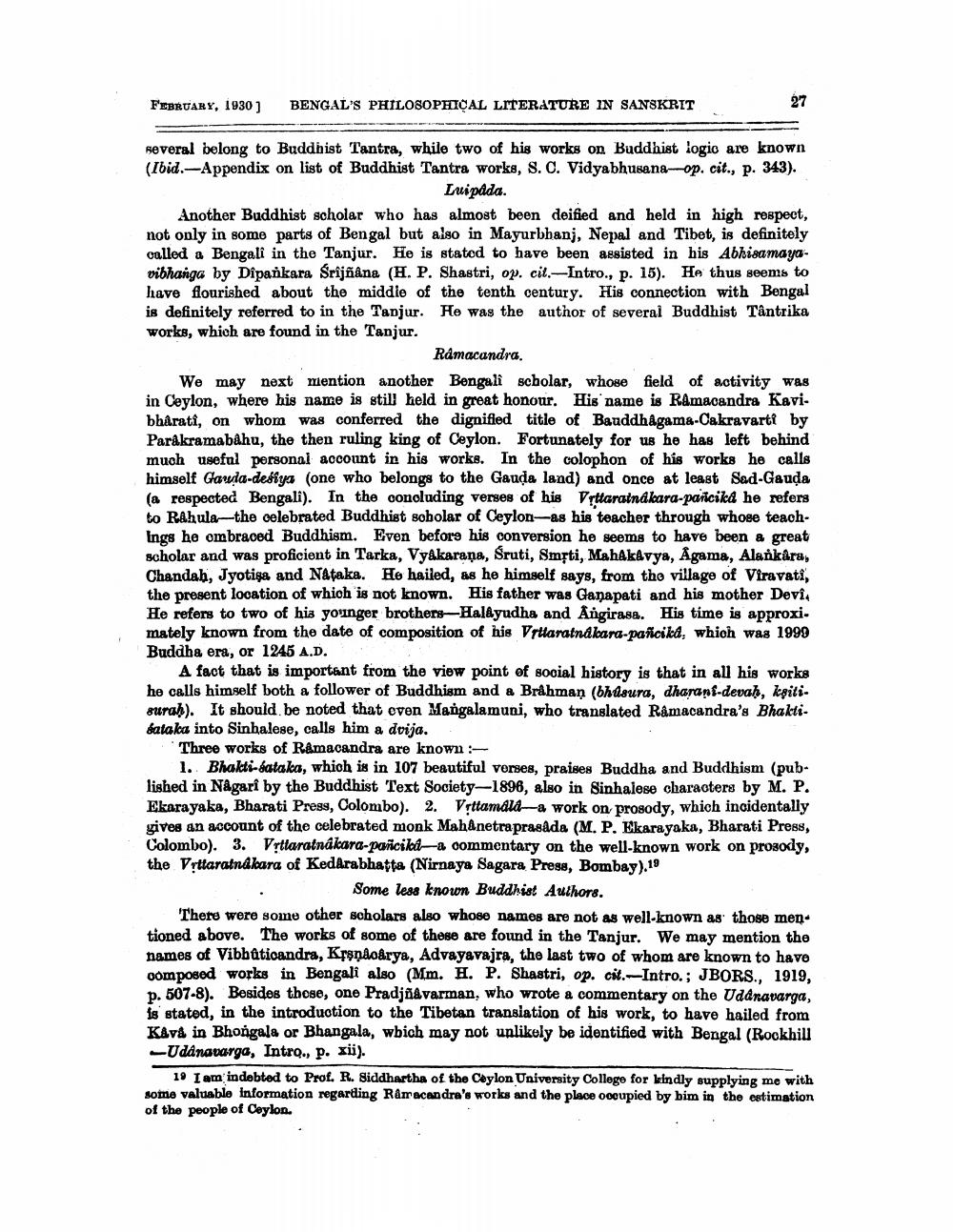________________
FEBRUARY, 1930)
BENGAL'S PHILOSOPHICAL LITERATURE IN SANSKRIT
several belong to Buddhist Tantra, while two of his works on Buddhist logio are known (Ibid.-Appendix on list of Buddhist Tantra works, S. C. Vidyabhusana-op. cit., p. 343).
Luipada. Another Buddhist scholar who has almost been deified and held in high respect, not only in some parts of Bengal but also in Mayurbhanj, Nepal and Tibet, is definitely called a Bengali in the Tanjur. He is stated to have been assisted in his Abhisamayavibhanga by Dipankara Srijñana (H. P. Shastri, op. cit.-Intro., p. 15). He thus seems to have flourished about the middle of the tenth century. His connection with Bengal is definitely referred to in the Tanjur. He was the author of several Buddhist Tântrika works, which are found in the Tanjur.
Ramacandra. We may next mention another Bengali scholar, whose field of activity was in Ceylon, where his name is still held in great honour. His name is Ramacandra Kavi. bharati, on whom was conferred the dignified title of Bauddhagama-Cakravarti by Parákramabahu, the then ruling king of Ceylon. Fortunately for us he has left behind much usefnl personal account in his works. In the colophon of his works he calls himself Gawla-desiya (one who belongs to the Gauda land) and once at least Sad-Gauda (a respected Bengali). In the conoluding verses of his Vittaraindkara-panicikd he refers to Rahule-the celebrated Buddhist sobolar of Ceylon-as his teacher through whose teachInge he embraced Buddhism. Even before his conversion he seems to have been a great scholar and was proficient in Tarka, Vyakarana, Sruti, Smrti, MahAkávya, Agama, Alankara, Chandah. Jyotiga and Nataka. Ho hailed, as he himself says, from tho village of Viravati. the present location of which is not known. His father was Ganapati and his mother Devid He refers to two of his younger brothers-Halayudha and Angirasa. His time is approxi. mately known from the date of composition of his Vrtlaratnakara-pañcika, which was 1999 Buddha era, or 1245 A.D.
A fact that is important from the view point of social history is that in all his works he calls himself both a follower of Buddhism and a Brahman (bhusura, dharanf-devah, ksiti. surah). It should be noted that oven Margalamuni, who translated Ramacandra's Bhaktidataka into Sinhalese, calls him a doija.
Three works of Ramacandra are known
1. Bhakti-bataka, which is in 107 beautiful verses, praises Buddha and Buddhism (published in Någarî by the Buddhist Text Society-1896, also in Sinhalese charaoters by M. P. Ekorayaka, Bharati Press, Colombo). 2. Vittamala-& work on prosody, which incidentally vives an account of the celebrated monk Mahånetra prasáda (M.P. Ekara yaka, Bharati Press, Colombo). 3. Vytlaratnákara-pancik-a commentary on the well-known work on prosoly, the Vittaratnálara of KedArabhatta (Nirnaya Sagara Press, Bombay).19
Some less known Buddhist Authors. 'There were some other scholars also whose names are not as well-known as those men. tioned above. The works of some of these are found in the Tanjur. We may mention the names of Vibbutioandra, Kronoarya, Advayavajra, the last two of whom are known to have composed works in Bengali also (Mm. H. P. Shastri, op. cit.--Intro.; JBORS., 1919, p. 507-8). Besides those, one Pradjñavarman, who wrote a commentary on the Uddnavarga, is stated, in the introduction to the Tibetan translation of his work, to have hailed from Kávå in Bhongala or Bhangala, wbich may not unlikely be identified with Bengal (Rockhill -Udanavarga, Intro., p. xü).
19 I am indebted to Prof. R. Siddhartha of the Ceylon University College for kindly supplying me with some valuable information regarding Ramacandra's works and the place occupied by bim in the estimation of the people of Ceylon.




